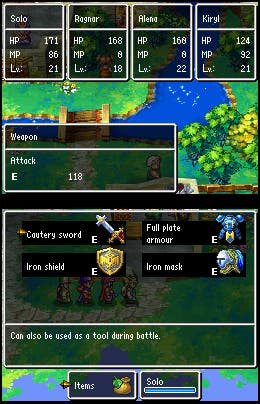Dragon Quest IV: Chapters of the Chosen
Blue in the face.
Mechanically the game is straightforward but robust, albeit with an execution that will seem a little unusual to players unused to Dragon Quest's idiosyncrasies. For instance, during battles your characters appear as portraits on the top screen, enemies lined up in front of you on the bottom, with only a menu system to link actions between the two. Saving, and resurrecting fallen characters all takes place in churches, meaning you'll need to trek to the nearest town if you want to record progress, a design choice that initially seems to labour a metaphor rather than provide slick functionality, but which in time becomes second nature.
Happily, if your team is wiped out in battle you'll be returned to the nearest church without losing any of your accrued experience, money or items, meaning that you'll never need to reload a save irritated at having lost half an hour's leveling.
Of course, this fawning praise doesn't come without reservations. The plot is clichéd, even if the narrative isn't; the option to quick-save only when on the world map is irritating and, while the environments spread across both screens, many of the most basic DS functions, such as touch-screen input, are ignored. By chapter 5 you'll have full manual control over all of your characters, but in the earlier parts of the game where the AI is backing you up in battles you'll curse its frequent idiotic decisions. Nevertheless, in terms of menu arrangement, and the nuts and bolts of interface design, this is better executed than last week's release of Final Fantasy IV.

While the Dragon Quest series continues to struggle to find a western audience (despite continuing to be the most popular videogame series in Japan) its creator, Yuuji Horii, is to the JRPG what Miyamoto is to the platform genre. His games are bright and engaging, accessible but never dumb, funny without being sarcastic, joyful but never simplistic, sweet but never saccharine. Horii knows how to make you feel good about playing his game and, for those with the type of brains predisposed toward the JRPG form and function, his game design is irresistible.
At one point, when you complete your first mission as McRyan, the king you serve offers you a parting gift: thousands of free experience points. It's a cute idea lent more impact by virtue of the fact you then get to sit watching as your character methodically increases level per level for free. As an in-game reward it is wholly meaningful, directly affecting the strength and efficiency of your character. As a result the simple sonic fanfare at every level up fills your mind with stupid endorphins as game design and story work together in rare harmony. Sure, it might just be the sight of numbers increasing in an almost arbitrary manner - something surely we should have grown tired of by now - but it works.
This is, of course, an old game, built for one of the earliest Japanese consoles, now dressed up and made modern for a new generation of players unborn the first time around. But despite its age, Dragon Quest IV is a heavyweight update of a marvellous game. Indeed, it emerges as the strongest RPG for the system, an extraordinary feat considering its long journey to get here. Blue moustache and all.
